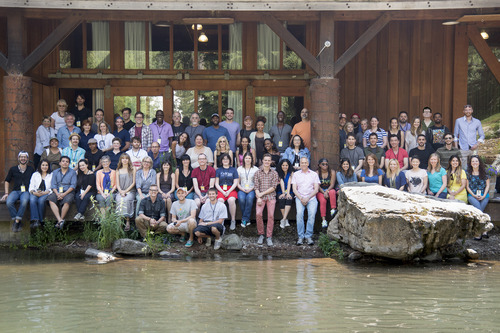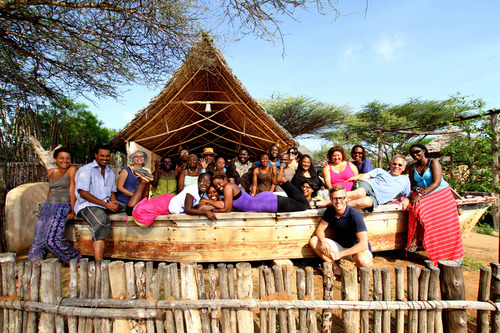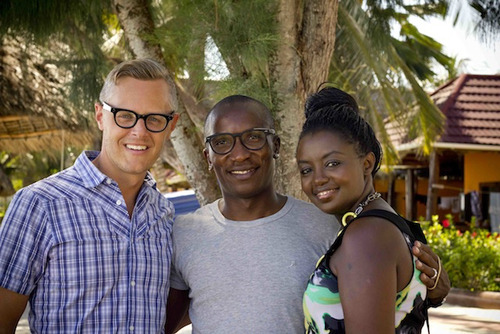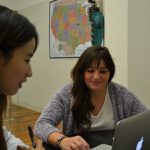Featured Interview with Christopher Hibma: Producing Director of the Theatre Program, Sundance Institute
NEW FEATURE FROM THE CON EDISON IMMIGRANT ARTIST NEWSLETTER NO. 65
Last week, we had a great chat with Christopher Hibma, Producing Director of the Theatre Program at the Sundance Institute. The fine art of relationship building was the strong thread that ran through our far-ranging conversation, which touched on the Sundance Theatre Program’s unique approach to new play development, their fourteen-year collaboration with artists in East Africa, their plans to continue expanding their international network, and how NYFA artists can get connected. Below are highlights from our conversation.
The Sundance Philosophy
Audience is (generally) an essential ingredient for theatre, yet the absence of a public audience seems to be a key aspect of the Sundance Institute Theatre Program’s centerpiece program, the Theatre Lab at Sundance Resort. (Every summer, around 90 theatre artists gather in Utah for three weeks of “theatre camp for adults,” where up to 6-8 unproduced theatre projects – generally text-based plays – are developed amongst playwrights, actors, directors, dramaturgs in an atmosphere of convivial support.)
CHRISTOPHER HIBMA: It was Robert Redford’s vision at the beginning of Sundance to make it an institution that stood apart from any commercial or public pressure. So it’s part of our DNA to allow the artist the opportunity to create and grow without that pressure. The process changes when you invite potential producers or presenters or even an audience for a Q&A into the room. There is value in having those particular audiences see work in progress, but it is incredibly rare for a sacred space like Sundance to be created for the artist to play around in. So I feel like we are sort of a holdout of a very pure and necessary element in new play development, which is: We’re going to be on our own and do this apart from public view. There’s enough time for an audience to participate in the work. Ninety percent of the work we develop reaches production, so audiences all over the U.S. and the world are seeing Sundance program plays.
Taylor Mac has said:
“I believe, to learn what your audience needs, is the job
But caution that sometimes we confuse need with want.
Giving our audiences what they want is not the job
Sometimes giving them what they want is a fringe benefit or happy accident but it is not the job.”
CH: Hopefully some of the work we’ve supported exists because we supported it. I don’t think that anyone would have ever thought that a play like I Am My Own Wife would have gone to Broadway. Or Fun Home, for example, which is coming this spring. A lesbian graphic novel – who thought? These are stories that audiences, in Taylor’s words, need to see and need to hear and need to experience, but the typical producing theatre is taking less and less risk.
90% of the projects developed at the Sundance Lab have been produced.
CH: If it were 100%, we wouldn’t be doing our jobs right. Because there always has to be that 10% that’s just a little too out there, to keep everyone guessing a little bit. We don’t actually want 100%. You need to keep pushing the envelope.
A core value:
CH: Discipline over a period of time and slowing down the creative process is a useful element in creating better work.
The gregarious hosts of new play development:
CH: It’s part of our philosophy that it’s not just what happens in the room that’s important at Sundance, but it’s the conversations around the dinner table, or at the bar, or on a chairlift ride up the mountain, or swimming in the ocean – that is as important as the work that’s being developed. My colleague Philip Himberg [Artistic Director of the Sundance Institute Theatre Program] is fond of saying we care more about the artists themselves. So what are the next ten plays that artist is going to write? That’s important to us.

International Exchange
In 1997, the Sundance Institute Theatre Program began expanding its network of artists internationally, first inviting observers to the Lab from outside of the U.S., and eventually establishing long-term collaborations with artists in East Africa. A new initiative focusing on artists in the Middle East and North Africa (MENA), is currently in the research and development phase, with a first Lab planned for 2016.
CH: One of the reasons that we started to engage internationally, and invite international artists to Sundance is that we felt, in general – no one specific – a lot of American playwrights’ stories have gotten so small. Small in scope, small in thought. And that by being next door to a woman who is trying to instill good dreams in her Rwandan colleagues after the Genocide, or a Tanzanian company talking about corruption in the government – that’s bound to change the way that, as an American, you write your work. Even if you’re not totally cognizant of it, it will change your plays. Or if we bring an American artist with us on a trip to Lebanon or to Egypt, that experience will change them. It changes us, as producers and administrators. In terms of audiences, in New York particularly, we would do ourselves better to think beyond our borders.
On theatre audiences in Ethiopia:
CH: Everyday at five o’clock, the theaters are full, like 2-3,000-seat theaters are full of fifteen-, sixteen-, seventeen-year-olds. Because theatre’s cheap, and it’s a valued form of entertainment, and TV is not ubiquitous. Whoever would have thought that in Addis Ababa, there are hordes of theatergoers?
Hibma is planning to produce a digital experience of Sundance’s 14-year initiative in East Africa, where he and his colleagues have continued their signature practice of shaping each program to the needs of the artists and of creating a safe space for artistic exchange. Two new theatre festivals in the region have evolved out of collaborations among alumni from the initiative and several local organizations and artists: the Kampala International Theatre Festival in Uganda and Crossing Boundaries in Ethiopia.
On how the initiative began:
CH: In 2002 my colleague Philip Himberg was invited by the Ford Foundation to do an assessment of the theatre in East Africa. During his trip to Uganda and Tanzania, he became aware of a generation of really interesting theatre artists who were creating work in the midst of tremendous social change, after the bombings in Kenya of the U.S. embassy, the Rwandan genocide, the child soldier epidemic in Northern Uganda. He became really excited with the artists who were creating in that area in the midst of their realities. So over the next couple of years we began inviting artists to come and visit us out at our spiritual home out at Sundance, Utah.
We wanted to see if [Sundance] values and philosophies resonated with our East African colleagues, because the last thing they needed was another group of white Westerners coming in to say, “This is how you make theatre.” And so it became important to us very, very early on to be as anti-Colonial about it as we possibly could, and so we began by asking a lot of questions and making regular trips to the region to meet artists. As you know in international exchange, it’s 99% about relationship building.

Quoted on the Sundance Institute Theatre Program’s website: “It is a good thing to place different civilizations in contact with each other; that whatever its own particular genius may be, a civilization that withdraws into itself atrophies; that for civilizations, exchange is oxygen.”
-Aimé Césaire, African poet and political theorist
CH: One of the big dilemmas we’ve had as we’ve worked internationally is: when do you say, “That’s not what we do?”
The issues and challenges in international engagement are so immense. What you do has to be what you do. Sundance develops new plays. We don’t present them, we don’t produce them. We aren’t humanitarians primarily. We’re not an NGO. We’re not a funder. We do laboratories. I think it’s really key for organizations to know who they are and to be clear about it.
[Starting the East African Initiative] we were encouraged to show up and just open our suitcases, metaphorically. To say, “This is who we are. We’re not hiding anything. We’re not trying to be exclusive. We’re not trying to pull the wool over anybody’s eyes. We’re not trying to support just a few people.” So we held these massive meetings with the public saying, “This is who we are,” just to demonstrate that philosophy. Showing up with an open suitcase goes along with that quote, “for civilizations, exchange is oxygen.” The world will only be a better place when we can all show up and open our suitcases and say, “This is who we are. Who are you? What do we have in common? How can we create a relationship with one another? What can we do together?”
All in all I’m proud of saying that a whole generation of East African theatre artists have been supported, and there’s a spotlight that’s been shown on them that is so rare for that part of the world, which is mostly known for its horrible news. And we’re proud to support the notion that there’s a contemporary, modern Africa that wants to engage with the world and does so in their own way.
Getting in Touch
What’s the best way for artists to connect with the program?
CH: We have an open submission every year from September 15th through November 15th, and anybody from the U.S. and all over the world can submit their work [for the Theatre Lab at Sundance Resort]. We currently receive about 900 proposals of full plays. We review every one of them. We become aware of many people through that process. So we become aware of musicals that might be better supported at our Lab at MASS MoCA in Massachusetts, or we become familiar with a writer that we want to explore more, so we invite them to our Playwrights & Composers Retreat [at Ucross Foundation] in Wyoming. So it’s a process through which we become familiar with artists.
Other ways to make contact:
CH: Invitations to showcases or readings or performances. We’re open to all of that. Actually going and seeing the work. That’s a really important element of it. It helps us get excited about the work if we can go see it, or experience it somehow. No matter where in the country or world that artists may be coming from.
You can email your invitations to: [email protected]
Sundance provides a great deal of support to artists beyond their Labs and Retreats, offering further development opportunities to alums in partnership with the Mellon Foundation, organizing exchange trips for international artists, and fostering further collaborations among the artists within their network. Building a relationship with Sundance is the first step.
CH: Sundance can support an artist in any number of ways. But it’s about relationship building, as opposed to opportunity grabbing. Right? I think that artists need to understand that.
The notion of creating relationships and establishing camaraderie with an institution is as important as the need, as the request.
For readers of the IAP Newsletter who are interested in the new Middle East and North Africa (MENA) Initiative:
CH: We are hiring a new staff person in the spring who will be our Manager for our MENA initiative (an Arabic & French speaker). This person will be the conduit through which these requests are funneled. We have such precious, rare opportunities for American artists to travel with us. However, we do feel like it’s a value to introduce American artists to other parts of the world and other artists globally. Those folks usually are our alumni. People who have already been through a Sundance program. But if there are artists from the Middle East and North Africa who are reading your newsletter or are immigrants from those parts of the world – there are many I know here in New York – just sending us an email and introducing themselves, inviting us to their work is the best thing. We can never know enough. We can always meet more artists. Who knows what might develop?
To learn more about Sundance Institute Theatre Program, visit their website.
– Interview conducted by Lisa Szolovits
Are you currently receiving NYFA’s free Con Edison Immigrant Artist Newsletter? Sign up to receive the monthly email featuring artist interviews, special reports, and upcoming arts deadlines and professional development resources. Click here to see highlights from this month’s issue.
Images, from top: Christopher Hibma, Faisal Kiwewa & Deborah Asiimwe at the 2013 Theatre Lab on Zanzibar, photo by Philippa Ndisi-Herrmann; 2015 Theatre Lab at the Sundance Resort Group Photo, photo by Jonathan Hickerson; 2011 Theatre Lab on Manda Group Photo, photo by Anastasia Krumkecheva.





